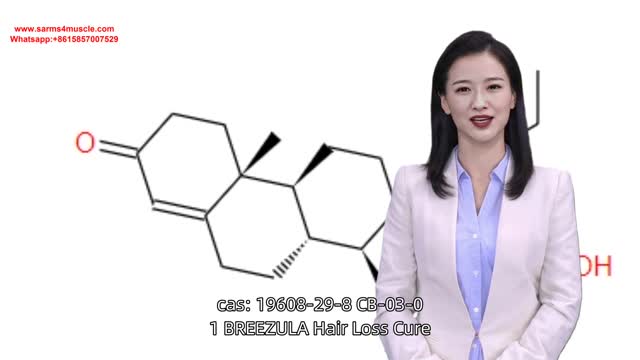Premium Only Content

cas: 19608-29-8 CB-03-01 BREEZULA Hair Loss Cure
cas: 19608-29-8 CB-03-01 BREEZULA Hair Loss Cure
What is CB-03-01?
CB-03-01 (cortexolone 17α-propionate, CB0301) 1% cream is a topical androgen receptor inhibitor which has mainly been developed for the treatment of acne vulgaris (1). It is also presently being investigated in a large phase II clinical trial for the topical treatment of male-pattern baldness. CB-03-01 has been found to inhibit the androgen receptor regulated pathway (1). Also known as clascoterone, CB-03-01 is being developed by Cassiopea (a spin-off company from Cosmo Pharmaceuticals) and was initially commercialised as Breezula. Data from 2020 reveal that clascoterone is also being marketed as Winlevi for the management of acne vulgaris. CB-03-01 is thought to compete with DHT for its binding to androgen receptors in both the sebaceous gland and dermal papilla cells within hair follicles. The difference between Winlevi and Breezula is that Breezula is a solution that contains a higher concentration of the drug for the treatment of male-pattern baldness(2). In 2019, Cassiopea announced positive phase II 12-month results for their flagship product Breezula in the management of androgenetic alopecia. The phase II clinical trial recruited in excess of 400 participants in Germany and sought to evaluate the efficacy and safety of 4 different dosing regimens of CB-03-01 compared to vehicle agents in male subjects between the ages of 18 and 55 with mild to moderate male-pattern baldness. All participants were randomised to either apply CB-03-01 or a vehicle agent to balding areas of the scalp daily for 12 months. 5 treatment groups were analysed – 2.5% solution twice-daily, 5.0% solution twice-daily, 7.5% solution twice-daily, 7.5% solution once-daily, and vehicle solution twice-daily.
Researchers used target area hair count (TAHC) and hair growth assessment (HGA) score as the primary end-points of interest. For TAHC, statistically significant changes versus the vehicle agent were observed in all of the active treatment groups, with the most significant improvements observed in the 7.5% twice-daily
-
 LIVE
LIVE
The Quartering
17 hours agoYule Log Christmas MAGA Edition With Memes! Come Hang Out!
2,099 watching -
 1:23:41
1:23:41
Game On!
17 hours ago $3.23 earnedNetflix NFL Christmas Games Preview and Predictions!
19.7K4 -
 2:05:07
2:05:07
Darkhorse Podcast
21 hours agoWhy Trump Wants Greenland: The 257th Evolutionary Lens with Bret Weinstein and Heather Heying
259K413 -
 8:50:58
8:50:58
Right Side Broadcasting Network
21 hours ago🎅 LIVE: Tracking Santa on Christmas Eve 2024 NORAD Santa Tracker 🎅
280K37 -
 2:48
2:48
Steven Crowder
1 day agoCROWDER CLASSICS: What’s This? | Nightmare Before Kwanzaa (Nightmare Before Christmas Parody)
267K12 -
 33:49
33:49
Quite Frankly
20 hours agoThe Christmas Eve Midnight Telethon
71.4K9 -
 2:12:46
2:12:46
Price of Reason
20 hours agoAmber Heard BACKS Blake Lively Lawsuit Against Justin Baldoni! Is Disney CEO Bob Iger in TROUBLE?
35.7K13 -
 1:01:17
1:01:17
The StoneZONE with Roger Stone
14 hours agoChristmas Edition: Why the Panama Canal is Part of the America First Agenda | The StoneZONE
110K42 -
 18:12:15
18:12:15
LFA TV
1 day agoLFA TV CHRISTMAS EVE REPLAY
128K14 -
 13:32
13:32
Scammer Payback
16 hours agoChanging the Scammer's Desktop Background to his Location
2.87K3